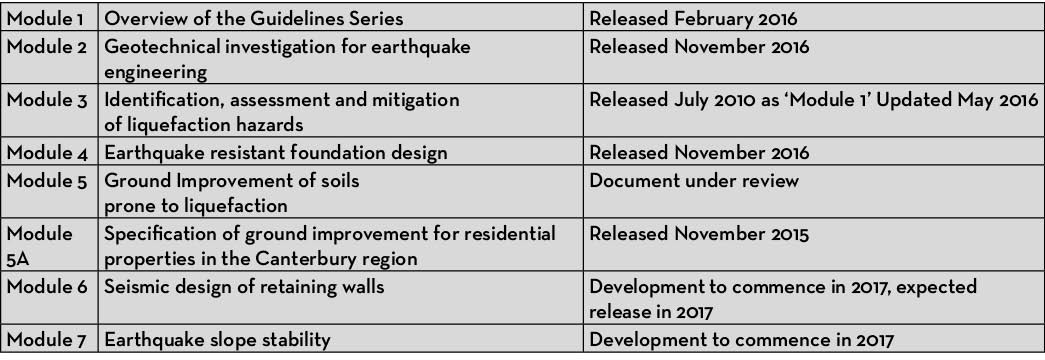
As I write this we seem to be experiencing déjà vu with another series of significant earthquakes. For some it will seem like reliving the Canterbury Earthquake Sequence, only under the guise of another name: the ‘Kaikoura Sequence’ perhaps? Whatever we name them they are a stark reminder (if we needed it) that we are living with the ever present threat of earthquakes, and that understanding them and how to engineer for them is very much part of what we do. Indeed for some of us it is virtually all we do. So it is fitting that one of the main efforts of the society at present, in conjunction with MBIE, is the development of the Earthquake Geotechnical Engineering Guidelines, of which two modules have just been released in November. Here is a ‘progress report’ on the development of the series.
The documents are all published as drafts for comment. It would be good to feel that there was significant input from a wide range of users, however very few comments have been received to date, which is a disappointment, and we are now making an appeal for feedback on all those modules released so far.
The updated Seismic Assessment of Existing Buildings has now been published with the new geotechnical section, C4, for which NZGS members had substantial input over an extended period: This document will become mandatory reading for anyone carrying out seismic assessment of existing buildings, so I would encourage you to become familiar with it.
Geotechnical engineering education programme
As mentioned in the last edition of Geomechanics News, we are in the process of developing an education programme with MBIE and IPENZ covering both the Earthquake Geotechnical Engineering Guidelines and other geotech topics. The programme was launched on Sept 1st through a new MBIE website page: https://www.building.govt.nz/building-code-compliance/geotechnical-education. Details will be added to the NZGS website in due course. The website includes all training information available on the earthquake geotechnical engineering guidelines issued to date, Modules 1, 2, 3, 4 and 5A, including some introductory webinars.
The first training under this programme, dealing with Module 3 (liquefaction assessment), was held in September, presented by Misko Cubrinovski and Kevin McManus. This was well received and we are considering running it again early next year. A webinar is also being developed aimed at a more advanced level than the seminars, and should be available within the next couple of months. Webinars addressing modules 1 and 5A are available for viewing, and can be linked to from recently issued NZGS weekly emails. These are valuable and I would encourage you to register and run through them. Further training is being developed for modules 2 and 4.
The Website
I trust that members will have noticed that we have a new website. Ross Roberts is now our website manager, and has been co-opted back on to the Management Committee (he was previously co-opted as Geomechanics News editor). This site offers much improved facilities on our old site, such as a shared calendar, which we hope will assist members.
YGP 2016 Conference
The 2016 YGP conference was held in Queenstown in October, attracting a record number of 50 delegates selected from 80 abstracts and presented over a period of two days. The three mentors and judges of the best paper competition (Darrell Paul, the immediate past chair of the Australian Geomechanics Society, Nick Wharmby and myself) were highly impressed by the quality of the presentations, many of which were the presenter’s first ever presentation. The best paper award for New Zealand delegates went to Phillipa Mills, for her paper on developing an understanding of the behaviour of volcanic soils, and the best Australian paper award went to Nigel Ruxton. Each of these has won a place in the 6th International Young Geotechnical Engineers’ Conference, to be held in September 2017 in Seoul, South Korea. Having heard the winners’ presentations I am confident that the two of them will do New Zealand and Australia proud. Papers by Romy Ridl and Hamish McEwan were also of exceptional quality and given highly commended awards. A delegates’ ‘most popular award’ went to Mondli Magagula, the delegate from South Africa, whose attendance at the conference was sponsored by the AGS. Delegates were delighted by his depiction of a large subsidence feature superimposed on a rugby field with the Wallabies playing the springboks, which he likened to the gap in the Springboks’ defence.
Thanks go to the organisers, Frances Neeson, David Buxton, Luke Storie and David Lacey, for their efforts in producing an excellent conference.
Bodies of Knowledge and Skills
Over the last six months the society has taken on the development of ‘Bodies of Knowledge and Skills’ for CEng level Geotechnical Engineers and for PEngGeol level Engineering Geologists. These documents will provide clear definitions of what knowledge these professionals can be expected to have at the point of becoming registered in each discipline. The Geotechnical Engineering document is now ready for issue for consultation, and the Engineering Geologists’ version is well advanced.
6ICEGE
The final report on last year’s 6ICEGE conference was released in August. This includes the results of the feedback survey, which showed overwhelmingly positive ratings for the conference. $72,531 of surplus from the conference has been passed to the society, on top of the return of the $20,000 seed funding, for the provision of scholarships for YGPs to the 7ICEGE conference in Rome 2019 and other NZ conferences, and for the publication of the invited papers to the conference in a Special Edition of Soil Dynamics and Earthquake Engineering.
Finally, with the extraordinary amount of ground damage from the new series of earthquakes now apparent, please take extra care of yourselves when carrying out inspections of unstable ground. Your safety is paramount.

An Update on the development of The Earthquake Geotechnical Engineering Guidelines
